CT Launches Entrepreneur Learner’s Permit to Cut Start-Up Fees
/Connecticut’s Entrepreneur Learner’s Permit program, operated by CTNext, is underway. The two-year pilot initiative, which reimburses first-time entrepreneurs for filing, licensing, and permitting fees associated with starting a business, is aimed at giving certain businesses a boost on the bottom line.
A wholly-owned subsidiary of Connecticut Innovations, CTNext is Connecticut’s innovation ecosystem, designed to build a more robust community of entrepreneurs and accelerate early-stage growth by providing access to talent, space, industry expertise, services, skill development, and capital to foster innovation and create jobs in Connecticut.
The Entrepreneur Learner’s Permit program, signed into law earlier this year, allows owners and executives of businesses in the information technology, bioscience, and green technology industries to receive reimbursement up to $1,500 for state and municipal business startup fees.
The Entrepreneur Learner’s Permit legislation sets a funding cap of $500,000 in Fiscal Years 2017 and 2018, equaling $1 million for reimbursable fees for entrepreneurs in the state.
Eligibility in the three industries has been defined by CTNext as the program gets started this month:
Bioscience: Defined as the manufacturing of pharmaceuticals, medicines, medical equipment, or medical devices and analytical laboratory instruments, operating medical or diagnostic testing laboratories, or conducting pure research and development in life sciences.
Information Technology: Defined as software publishing, motion picture and video production, teleproduction and post-production services, telecommunications, data processing, hosting and related services, custom computer programming services, computer system design, computer facilities management services, other computer related services and computer training.
Green Technology: Defined as the production, manufacture, design, research or development of clean energy, green buildings, smart grid, high-efficiency transportation vehicles and alternative fuels, environmental products, environmental remediation and pollution prevention.
Glendowlyn Thames, director of Small Business Innovation and CTNext at Connecticut Innovations, recently told Hartford Business Journal that “Starting and running a business in its earliest stages can be a massive undertaking, no matter the location. This benefit does more than cover fees — it is another step the state has taken to help create a more active ecosystem and assist entrepreneurs when they need it most. Entrepreneurs scrutinize every cost, so while the fees may not deter a company from coming to Connecticut, removing those fees can certainly serve as a benefit.”
The Connecticut Business and Industry Association has described the program as “a pro-small business, solid stepping stone toward paving the way for Connecticut to become a much more business friendly state.” The legislation establishing the program was authored by State Rep. Caroline Simmons-D-144 and State Sen. Scott Frantz-R-36, the Stamford Advocate reported.
“Our vision is to attract new businesses to Connecticut and to encourage entrepreneurship and job growth in our state,” Simmons told the Advocate. “This is a pro-business, bi-partisan bill that will benefit Connecticut's economy.”
The legislature’s Office of Fiscal Analysis (OFA) estimated the program will cost the state $27 million annually in lost fee revenue; other agencies like transportation and banking will lose $7 million annually. OFA assumes 25,000 startups launch in Connecticut every year.
CTNext, described as Connecticut’s innovation ecosystem, is tasked under revisions to the state’s economic development structure approved by the state legislature to “equip startups and entrepreneurs with resources, guidance and networks to accelerate growth and success.” CTNext launched in 2012, and has worked with more than 1,100 companies.
Companies need to certify that they are eligible for the Entrepreneur Learner’s Permit program, and after filling out a very brief online application, a “CTNext team member will reach out to you to collect receipts for reimbursement.” At the end of the two-year program, CT Innovations is to evaluate its effectiveness and make a recommendation to the legislature regarding whether it should be continued, concluded, or revised.
https://youtu.be/U0vyYsDrl10




 Individual municipalities and state agencies also have options to purchase additional products as needed, such as 3-D building footprints, planimetrics, landcover maps, impervious surface maps and more, according to company officials.
Individual municipalities and state agencies also have options to purchase additional products as needed, such as 3-D building footprints, planimetrics, landcover maps, impervious surface maps and more, according to company officials.
 "Our flight team did an exceptional job of outmaneuvering the unusual weather present during the collection period (in Connecticut)," says Shawn Benham, Sanborn project manager. "The savings truly are astronomical when you merge many smaller project areas into a single large project because of the fixed costs associated with each mobilization," added Arshat in statement released by the company.
"Our flight team did an exceptional job of outmaneuvering the unusual weather present during the collection period (in Connecticut)," says Shawn Benham, Sanborn project manager. "The savings truly are astronomical when you merge many smaller project areas into a single large project because of the fixed costs associated with each mobilization," added Arshat in statement released by the company.



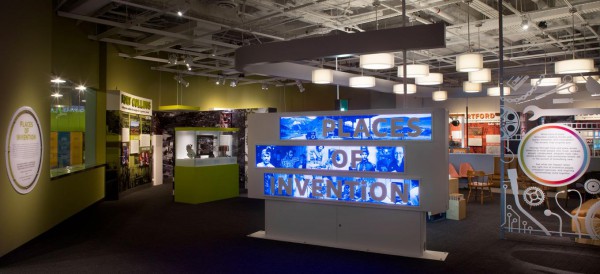 Describing Hartford’s prominent manufacturing history, Hinz said “Hartford, CT, is a classic story in the history of American technology. If you have ever wondered why people refer to “Yankee ingenuity,” this is what they are talking about.” He adds, “In the mid and late 1800s, the United States overtakes Great Britain as the world’s foremost economic superpower, largely on the strength of its prowess in inventing and manufacturing new technologies. Hartford is at the center of that revolution.”
Describing Hartford’s prominent manufacturing history, Hinz said “Hartford, CT, is a classic story in the history of American technology. If you have ever wondered why people refer to “Yankee ingenuity,” this is what they are talking about.” He adds, “In the mid and late 1800s, the United States overtakes Great Britain as the world’s foremost economic superpower, largely on the strength of its prowess in inventing and manufacturing new technologies. Hartford is at the center of that revolution.” The exhibit notes that by the 1850’s “Hartford became the center of production for a wide array of products—including firearms by Colt, Richard Gatling and John Browning; Weed sewing machines; Royal and Underwood typewriters; Columbia bicycles; and even Pope automobiles.”
The exhibit notes that by the 1850’s “Hartford became the center of production for a wide array of products—including firearms by Colt, Richard Gatling and John Browning; Weed sewing machines; Royal and Underwood typewriters; Columbia bicycles; and even Pope automobiles.”
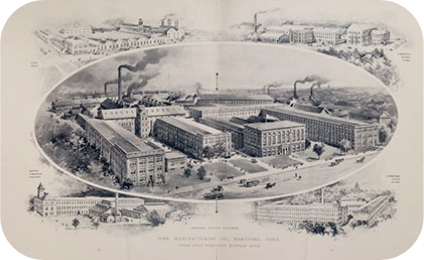 rode his high-wheeler from the station down Capitol Avenue to the Weed Sewing Machine Company.’”
rode his high-wheeler from the station down Capitol Avenue to the Weed Sewing Machine Company.’”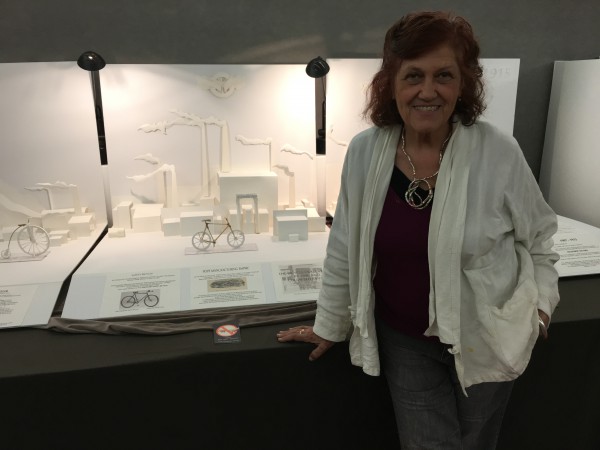 Jeanne Manzelli, a resident of Windsor, has a
Jeanne Manzelli, a resident of Windsor, has a 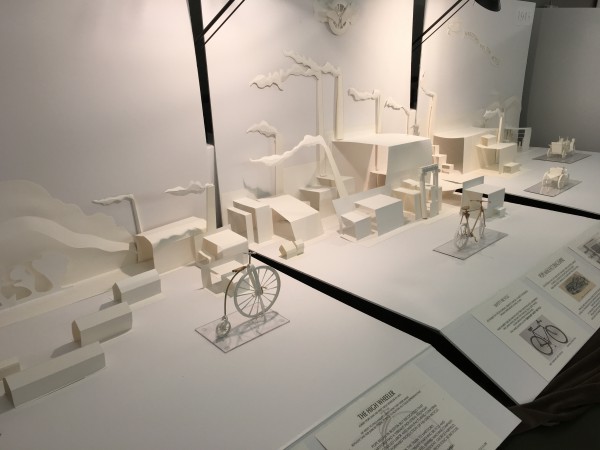 BFA in Sculpture from the Massachusetts College of Art and her MED in Art Education from the University of Massachusetts, Amherst. Her experience includes a 20 year career in design, manufacture, appraisal and sale of jewelry, two decades as mural artist working closely with interior designers as an industry professional, and 14 years teaching basic and advanced drawing, sculpture and 3D design as well as color theory at Tunxis Community College.
BFA in Sculpture from the Massachusetts College of Art and her MED in Art Education from the University of Massachusetts, Amherst. Her experience includes a 20 year career in design, manufacture, appraisal and sale of jewelry, two decades as mural artist working closely with interior designers as an industry professional, and 14 years teaching basic and advanced drawing, sculpture and 3D design as well as color theory at Tunxis Community College.



 In addition to its impact on drivers, the AMA notes that blue-rich LED streetlights operate at a wavelength that most adversely suppresses melatonin during night. It is estimated that white LED lamps have five times greater impact on circadian sleep rhythms than conventional street lamps, the AMA indicated. Recent large surveys, according to the AMA, found that brighter residential nighttime lighting is associated with reduced sleep times, dissatisfaction with sleep quality, excessive sleepiness, impaired daytime functioning and obesity.
In addition to its impact on drivers, the AMA notes that blue-rich LED streetlights operate at a wavelength that most adversely suppresses melatonin during night. It is estimated that white LED lamps have five times greater impact on circadian sleep rhythms than conventional street lamps, the AMA indicated. Recent large surveys, according to the AMA, found that brighter residential nighttime lighting is associated with reduced sleep times, dissatisfaction with sleep quality, excessive sleepiness, impaired daytime functioning and obesity.
 The Conversation website is a collaboration between editors and academics to provide "informed news analysis and commentary that’s free to read and republish." It
The Conversation website is a collaboration between editors and academics to provide "informed news analysis and commentary that’s free to read and republish." It 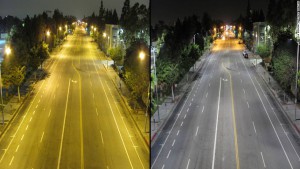 PHOTO: Traditional street lighting (left) vs. LED lighting (right).
PHOTO: Traditional street lighting (left) vs. LED lighting (right).


































